

Jumping Spiders Seem to Have a Cognitive Ability Only Previously Found in Vertebrates. Tiny little jumping spiders, with their magnificent eyes, seem to be able to do something we'd only ever seen before in vertebrates: distinguishing between animate and inanimate objects.
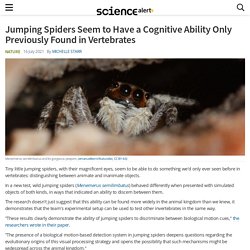
In a new test, wild jumping spiders (Menemerus semilimbatus) behaved differently when presented with simulated objects of both kinds, in ways that indicated an ability to discern between them. The research doesn't just suggest that this ability can be found more widely in the animal kingdom than we knew, it demonstrates that the team's experimental setup can be used to test other invertebrates in the same way. "These results clearly demonstrate the ability of jumping spiders to discriminate between biological motion cues," the researchers wrote in their paper. This video is designed to create a natural hallucination based on the motion aftereffect illusion : woahdude.
Dump the “dimorphism”: Comprehensive synthesis of human brain studies reveals few male-female differences beyond size. Achiron et al., 2001 R.
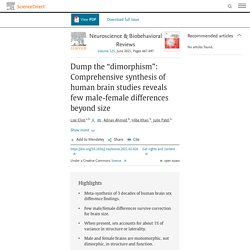
Sex differences in the IQ-white matter microstructure relationship: a DTI study. Is there a sex difference in IQ scores? The strongest evidence for our position consists of a meta-analysis3 derived from 57 general-population samples, many of which are normative or carefully constructed representative samples, with a total of 80,928 participants.

This reveals no sex difference in general cognitive ability up to the age of 14 and a significant sex difference at 15, which then increases to its adult value of 5 IQ points in favour of males. There is further evidence for a mean male advantage of 4–6 IQ points in four independent adult samples5,6,7 (n = 11,896); Jackson and Rushton8, in a huge standardization sample (n = 102,515) that is much bigger than the Mexico study9, also reported a male advantage of 3.6 IQ points among 17-year-olds, which is somewhat greater than our estimates3,4 for this age group.
A distributed brain network predicts general intelligence from resting-state human neuroimaging data. The causal influence of brain size on human intelligence: Evidence from within-family phenotypic associations and GWAS modeling. The causal influence of brain size on human intelligence: Evidence from within-family phenotypic associations and GWAS modeling. Predicting intelligence from brain gray matter volume.
Chapter 18 - Learning and Memory. Chapter 18.
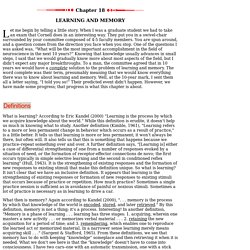
Learning and Memory (Section 4, Chapter 7) Neuroscience Online: An Electronic Textbook for the Neurosciences. The analysis of the anatomical and physical bases of learning and memory is one of the great successes of modern neuroscience.
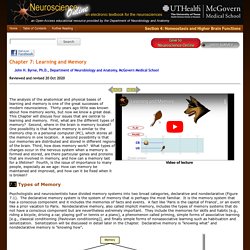
Thirty years ago little was known about how memory works, but now we know a great deal. This Chapter will discuss four issues that are central to learning and memory. Habituation, sensitization, and Pavlovian conditioning. Identification of the necessary and sufficient conditions for the formation of associations has been a driving influence on learning theory and research.
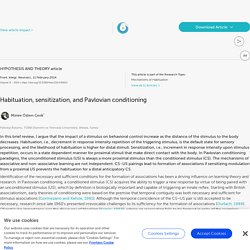
In Pavlovian conditioning, a conditioned stimulus (CS) acquires the ability to trigger a new response by virtue of being paired with an unconditioned stimulus (US), which by definition is biologically important and capable of triggering an innate reflex. Starting with British associationism, early theories of conditioning were based on the premise that temporal contiguity was both necessary and sufficient for stimulus associations (Gormezano and Kehoe, 1981). Although the temporal coincidence of the CS−US pair is still accepted to be necessary, research since late 1960's presented irrevocable challenges to its sufficiency for the formation of associations (Durlach, 1989). The Impact of a Stimulus Decreases with its Distance from the Body One would only expect that the organization of learning mirrors the organization of behavior. Learning and Memory (Section 4, Chapter 7) Neuroscience Online: An Electronic Textbook for the Neurosciences.
The Biological Nature of Learning. Circuit Mechanisms of Sensorimotor Learning. Neural plasticity and behavior - sixty years of conceptual advances. This brief review summarizes 60 years of conceptual advances that have demonstrated a role for active changes in neuronal connectivity as a controller of behavior and behavioral change.
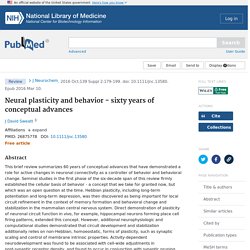
Seminal studies in the first phase of the six-decade span of this review firmly established the cellular basis of behavior - a concept that we take for granted now, but which was an open question at the time. Study finds that by age 3 kids prefer nature's fractal patterns. Before their third birthdays, children already have an adult-like preference for visual fractal patterns commonly seen in nature, report University of Oregon researchers.

That discovery emerged among children raised in a world of Euclidean geometry, such as in houses with rooms constructed with straight lines in a simple nonrepeating manner, said Kelly E. Robles, a doctoral student in the Department of Psychology. “Unlike early humans who lived outside on savannahs, modern-day humans spend the majority of their early lives inside these manmade structures,” Robles said. Changes in Thickness and Surface Area of the Human Cortex and Their Relationship with Intelligence. Skip to Main Content Advertisement Search Close Advanced Search Search Menu.
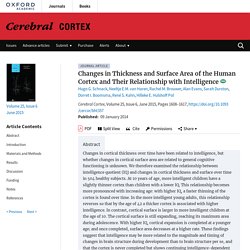
This baby bird instinctively mimics a poisonous caterpillar when it senses a predator nearby : natureismetal. What We Know, Are Still Getting Wrong, and Have Yet to Learn about the Relationships among the SAT, Intelligence and Achievement. In learning styles debate, it's instructors vs. psychologists. A couple of years ago, the science writer Ulrich Boser wondered: Do educators still believe in learning styles? The idea that some students are auditory learners, while others flourish by having information presented visually, through motion or otherwise is nearly a century old. It grew in popularity in the 1950s, then again in the 1970s, but for much of the past decade scientists have warned that it has little merit.
Boser, founder of the Learning Agency, a Washington consulting and communications group, had long followed the field. He was researching a book about learning strategies and knew that scientists had debunked learning styles, most notably in a widely discussed 2009 paper -- in it, they said building instruction around the concept was an “unwise and a wasteful use of limited resources.” So he set up a Google alert for the term. Educators continue to invoke the idea, he said. Visual cortex genetically organized. Serotonin & Cognition. Genes, Emotions, Gut. Affect & Consciousness in Animals. Emotional Groups - Biomarkers? 'Taste Display' Brings Fake Flavors to Your Tongue. Painting without a brush : Unexpected. THE BRAIN OBSERVATORY® A Decade After Death Patient HM Inspires Plans For Brain Museum In Downtown San Diego.
Dreams. Consciousness. Biology of Classical and Operant Conditioning. Movement, Exercise, Learning, Brain Training. Emotion. Learning and Memory. Problem Solving. Cognition & Consciousness. CognitiveMaps. Brain training exercises just make you better at brain training exercises – Research Digest. By Christian Jarrett If you spend time building your physical strength and stamina in the gym, you can expect to carry these benefits into everyday life.

It will be easier for you to lug heavy shopping bags around or run for the bus. You will likely reduce your chances of developing cardiovascular and other illnesses. A new review of brain training games in Psychological Science in the Public Interest – the most comprehensive ever conducted – shows that unfortunately the same principle does not hold for these games. When you spend time completing mental exercises on your phone or computer, you will most likely only become better at those exercises or very similar tasks. Commercial brain training games, which involve performing simple memory, attention and reaction time tasks, which usually get more difficult as you improve, are hugely popular.
When expert opinion divides in this way it can be difficult to know who to trust. It is also objective. Their verdict is stark. Related In "Brain" The brainstem reticular formation is a small-world, not scale-free, network. Exceptional Memory Explained: How Some People Remember What They Had for Lunch 20 Years Ago. Researchers from the University of California, Irvine reported in 2006 on a woman named Jill Price who could remember in great detail what she did on a particular day decades earlier. James McGaugh, Larry Cahill and Elizabeth Parker put the woman through a battery of tests and ascertained that she was not using any of the memory tricks that have been known to mnemonists for millennia.
Word got out, the media descended and the lab now receives calls every day from people who say they have the same ability as Price. Of the hundreds of people interviewed, 22 appear to exhibit what the researchers call highly superior autobiographical memory (HSAM), the detailed recollection of events that occurred in the distant past. Effects of ageing on touch. Basal Ganglia Impairments in Autism Spectrum Disorder Are Related to Abnormal Signal Gating to Prefrontal Cortex. Olfaction. Study: IQ doesn't equal intelligence. Feeling demoralised after you slacked off work to take an online IQ test - and scored dismally? No need to worry, you may not be as stupid as it says you are. The study explains: Each behavioural component is associated with a distinct functional brain network. Using 12 distinct cognitive tasks, designed to measure planning, reasoning, attention and working memory abilities, the study compared models of individual performance with models of brain functional organisation.
Mind Reading. Numbers & Math. Language. Orbitofrontal, taste, smell, appetite, emotion [Acta Physiol Hung. 2008. Rhythm. MusicBrain. Categories. Perineuronal Net LTM Tsien 2013. Science of Brain Training Creates Inconvenient Facts - ForexTV. SAN FRANCISCO, Oct. 04, 2016 (GLOBE NEWSWIRE) — Dr. Henry Mahncke, the CEO of Posit Science—the provider of brain exercises backed by the most peer-reviewed papers in the industry—responded today to a new critique of brain training published in Psychological Science in the Public Interest.
“While our company was treated relatively well compared to what was said about others in the industry, I am obligated to respond,” Dr. Mahncke said. “After all, the scientific foundation for turning the discovery of lifelong plasticity into products that can help people has largely been laid by scientists at Posit Science and our academic colleagues from around the world.”
“The critics in this latest review begin with century-old experiments and theories on the failure of traditional cognitive training to drive benefits that extend beyond the task trained,” Dr. In a blog post at Dr. “It’s a shame that old school psychology and modern neuroscience seem to be talking past each other,” Dr.